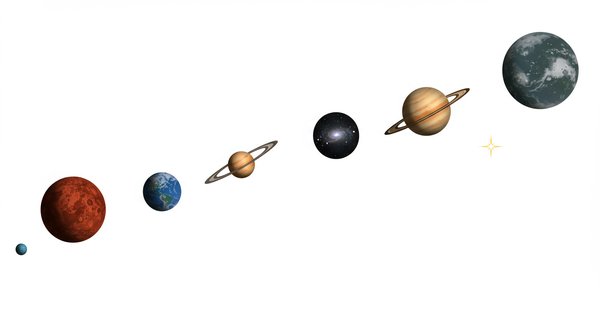Lesson
Introduction to Astronomy
Welcome to the fascinating world of astronomy! Astronomy is the study of everything in the universe beyond Earth's atmosphere. This includes planets, stars, galaxies, black holes, and even the universe as a whole. It's a science that combines observation, physics, mathematics, and computer science to help us understand our place in the cosmos.
Why Study Astronomy?
You might wonder, why bother studying something so far away? There are many compelling reasons. Firstly, astronomy helps us understand the origins of our solar system, our planet, and even life itself. By studying other stars and planets, we gain insights into how our own came to be.

Secondly, astronomy pushes the boundaries of human knowledge and technology. Developing telescopes and spacecraft to explore the universe requires innovation in engineering, materials science, and computing. These advancements often have practical applications here on Earth.
Thirdly, astronomy provides a unique perspective on our place in the universe. It reminds us that Earth is just one small planet orbiting an ordinary star in a vast and ancient cosmos. This perspective can be both humbling and inspiring, encouraging us to appreciate the fragility of our planet and the importance of preserving it.
Key Concepts in Astronomy
Astronomy involves many different concepts and scales. Here are a few fundamental ideas we will explore:
- Celestial Objects: These are natural objects located outside of Earth's atmosphere. Examples include stars, planets, moons, asteroids, comets, nebulae, and galaxies.
- Light-Years: Because space is so vast, astronomers use light-years to measure distances. A light-year is the distance light travels in one year, which is approximately 9.461 × 1012 kilometers. \( d= speed \times time \)
- Gravity: Gravity is the force that attracts objects with mass towards each other. It's the force that keeps planets in orbit around stars and galaxies together.
- Electromagnetic Spectrum: This is the range of all types of electromagnetic radiation, including radio waves, microwaves, infrared, visible light, ultraviolet, X-rays, and gamma rays. Astronomers use telescopes to observe different parts of the electromagnetic spectrum, which reveals different aspects of celestial objects.

Celestial Objects
Let's delve deeper into some key celestial objects:
- Stars: Stars are massive, luminous spheres of plasma held together by their own gravity. They produce energy through nuclear fusion in their cores. Our Sun is a star.
- Planets: Planets are celestial bodies that orbit a star. They are massive enough to have cleared their orbital path of other objects. There are eight planets in our solar system: Mercury, Venus, Earth, Mars, Jupiter, Saturn, Uranus, and Neptune.
- Moons: Moons, also known as natural satellites, orbit planets. Earth has one moon, while other planets have many.
- Asteroids: Asteroids are rocky or metallic bodies that orbit the Sun, mostly found in the asteroid belt between Mars and Jupiter.
- Comets: Comets are icy bodies that release gas and dust as they approach the Sun, creating a visible tail.
- Nebulae: Nebulae are clouds of gas and dust in space. They are often the birthplaces of stars.
- Galaxies: Galaxies are vast collections of stars, gas, dust, and dark matter held together by gravity. Our solar system is located in the Milky Way galaxy.
Tools of Astronomy
Astronomers use a variety of tools to study the universe:
- Telescopes: Telescopes are used to collect and focus light from distant objects. There are two main types of telescopes: optical telescopes, which use lenses or mirrors to focus visible light, and radio telescopes, which detect radio waves.
- Spacecraft: Spacecraft are used to explore planets, moons, and other celestial objects up close. They can carry instruments to measure the composition, temperature, and magnetic fields of these objects.
- Spectrographs: Spectrographs are used to analyze the light from stars and other objects. By studying the spectrum of light, astronomers can determine the object's temperature, composition, and velocity.
- Computers: Computers are essential for analyzing the vast amounts of data collected by telescopes and spacecraft. They are also used to create simulations of astronomical phenomena.
Distances in Space
The distances in space are so immense that using kilometers or miles becomes impractical. That's why astronomers use light-years. One light-year is equivalent to approximately 9.461 x 1012 kilometers (9.461 trillion kilometers). For instance, the nearest star to our Sun, Proxima Centauri, is about 4.24 light-years away.
The Importance of Gravity
Gravity plays a crucial role in astronomy. It is the force that holds stars, planets, and galaxies together. Newton's Law of Universal Gravitation describes the force of gravity between two objects:
Where:
- \(F\) is the force of gravity
- \(G\) is the gravitational constant (approximately 6.674 × 10-11 N(m/kg)2)
- \(m_1\) and \(m_2\) are the masses of the two objects
- \(r\) is the distance between the centers of the two objects
Einstein's theory of General Relativity provides a more complete description of gravity, explaining it as a curvature of spacetime caused by mass and energy.
The Electromagnetic Spectrum
The electromagnetic spectrum is the range of all types of electromagnetic radiation. Different wavelengths of light reveal different aspects of celestial objects. For example, radio waves can penetrate clouds of gas and dust, allowing astronomers to study the centers of galaxies. X-rays can reveal the presence of black holes and other high-energy phenomena.
Conclusion
Astronomy is a vast and exciting field that offers us a glimpse into the workings of the universe. By studying the cosmos, we can learn more about our origins, our place in the universe, and the fundamental laws of nature. This is just the beginning of your astronomical journey! Keep exploring, keep questioning, and keep looking up!












